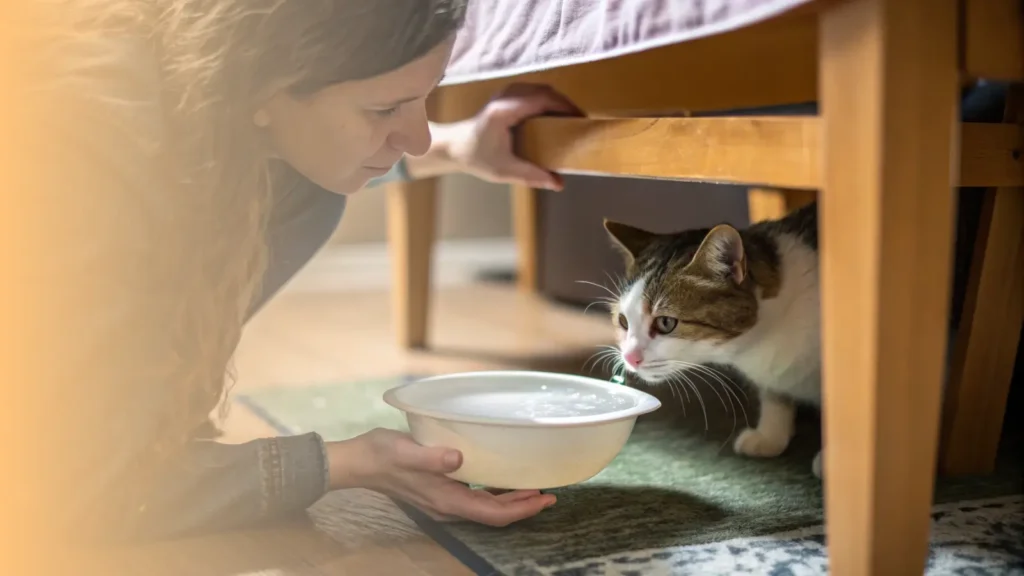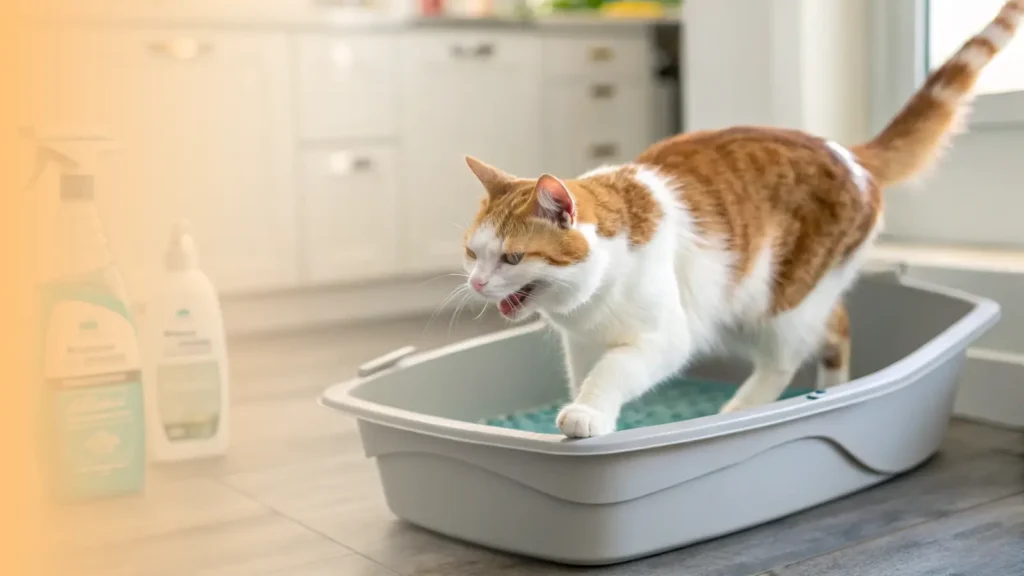It’s a feeling every cat owner knows, that quiet sense of worry when you look at your companion and just feel that something is off. Before you panic, I’ve learned that the most powerful tool you have is your own observation. Your cat gives you subtle clues about their health all the time, you just need to know how to read them.
Key Takeaways
- Your cat’s overall behavior is the most reliable sign of illness, not the temperature or moisture of its nose.
- The most significant behavioral clues that your cat may have a fever include deep lethargy, unusual hiding, and a loss of appetite.
- A shivering cat trying to find warmth likely has a true fever, while a panting cat stretched out on a cool floor is likely overheating.
- You must never give your cat human medications like Tylenol or Advil as they are extremely poisonous and can be fatal.
Why Your Cat’s Behavior Is the Most Reliable Indicator
1. The Problem with the “Warm, Dry Nose” Myth
The idea that a warm, dry nose means a cat is sick is a medically unfounded piece of folklore. A cat’s nose can become warm and dry for many harmless reasons, like after they have been napping in a sunbeam or are just a bit dehydrated from sleep. In my experience, relying on this myth can cause owners to miss the much more important behavioral signs of actual illness.
2. Why Cats Instinctively Hide Sickness
Cats are masters at masking their symptoms because it is a survival instinct inherited from their wild ancestors. In the wild, showing any sign of weakness would make a solitary hunter an easy target for predators or rivals. This is why your domestic cat will often retreat and hide its illness until it may be quite advanced, making your careful observation the most critical first alert system.
Key Behavioral Signs of Sickness in Cats
The following “sickness behaviors” are a coordinated strategy your cat’s body uses to conserve the tremendous energy it needs to fight off a threat.
1. Extreme Lethargy or Unresponsiveness
Pathological lethargy is a deep, persistent state of weariness and inactivity that does not get better with rest. A normally tired cat might nap frequently but can still be roused by the sound of their favorite treats or will engage in play if prompted. A truly lethargic cat shows a profound lack of interest in everything it usually enjoys, from food and toys to social attention.
2. Hiding or Avoiding Social Interaction
A sick cat feels vulnerable and will instinctively seek out a secluded, safe spot to hide from any perceived threats. This is a very powerful signal that something is wrong. When I see a normally social cat suddenly become reclusive or an independent cat refuse to come out from under the bed, I know it’s time to pay very close attention.
3. Refusing to Eat or Drink
A sudden loss of appetite is one of the most common and earliest signs of almost any significant feline illness. The simple acts of consuming and digesting food require energy that the body must redirect to its immune system when it’s fighting a battle. A lack of appetite that lasts for more than 24 hours is always a reason to be concerned and should prompt a call to your vet.
4. Neglecting to Groom
A healthy cat is a fastidious groomer, spending a large portion of its day keeping its coat in immaculate condition. When a cat feels unwell, grooming is one of the first non-essential activities it will stop doing. An unkempt, greasy, or matted coat is a strong indicator of malaise because grooming requires both physical flexibility and energy, both of which are diminished in a sick cat.
What Physical Signs Can Point to a Fever?
While behavior provides the most reliable clues, certain physical signs can help confirm your suspicions that your cat is unwell.
1. Shivering or Trembling
Shivering is a direct, visible sign that your cat’s body is trying to generate heat to meet a higher internal temperature. This occurs when the immune system has reset the body’s internal thermostat to help fight an infection. The body then works to warm itself up to meet this new, higher set point.
2. Faster Breathing or Heart Rate
A fever increases the body’s overall metabolic rate. To meet the increased demand for oxygen and to circulate immune cells more quickly, both the respiratory and heart rates will often speed up. While difficult to measure accurately without training, visibly rapid breathing in a resting cat is a significant finding.
3. Signs of Dehydration
You can check for dehydration by gently lifting the skin over the scruff of your cat’s neck. In a well-hydrated cat, it should snap back into place immediately. If it returns slowly or stays in a slight “tent”, the cat is likely dehydrated. Other key signs include gums that feel tacky or dry to the touch instead of slick and moist.
Fever vs. Overheating: What’s the Difference?
What I found to be a critical piece of information is understanding if your cat is trying to get warm or trying to cool down, as this points to two very different problems.
1. What Is a True Fever (Pyrexia)?
A true fever, known as pyrexia in veterinary terms, is a controlled increase in body temperature directed by the immune system to fight a threat like a virus. The cat’s internal thermostat in the brain is intentionally reset to a higher temperature. Because its body now thinks its normal temperature is too cold, it will show heat-seeking behaviors like shivering, curling into a tight ball, and seeking warm spots.
2. What Is Overheating (Hyperthermia)?
Hyperthermia is a dangerous, uncontrolled rise in temperature where the body’s cooling systems are overwhelmed, like when a cat is in a hot room without ventilation. The body’s thermostat remains normal. The cat knows it is too hot and will show heat-dissipating behaviors like panting, which is always a serious sign in cats, or stretching out on a cool tile floor.
| Feature | True Fever (Pyrexia) | Overheating (Hyperthermia) |
|---|---|---|
| Cat’s Sensation | Feels “cold” and tries to get warm. | Feels dangerously “hot” and tries to cool down. |
| Key Behaviors | Shivering, huddling, seeking warm spots. | Panting, stretching out on cool surfaces. |
| Appropriate Action | Provide warmth and comfort. Do not actively cool. | Active cooling is necessary. Move to a cool area. |
Common Reasons Why Cats Get Fevers
A fever is not a disease itself but a clear sign that the immune system is actively fighting an underlying problem. Veterinary studies show that in cats, infectious diseases are overwhelmingly the most common cause. This includes viral infections like Feline Leukemia (FeLV), as well as bacterial infections that can result from a bite wound abscess, severe dental disease, or a urinary tract infection. In fact, one major study found that the fatal disease Feline Infectious Peritonitis (FIP) was the single most common cause of fever in referred cats. Other causes can include non-infectious inflammation, cancer, or even a reaction to certain medications.
What to Do If You Suspect Your Cat Is Sick
Recognizing the signs is the first step, but knowing how to respond safely is just as important.
1. How to Provide Safe Care at Home
If your cat is showing mild signs of illness, your main goal is to provide comfort and prevent dehydration while you monitor them. Create a quiet, warm, and comfortable recovery room with a soft bed and easy access to a litter box, fresh water, and food. You can encourage a reluctant cat to drink by offering them wet food or adding a little low-sodium chicken broth to their water. Gently warming their food can also make it more appealing. The most critical rule is to never give your cat any human medications, as they can be deadly.
2. Urgent Signs That Require a Vet Visit
You should contact your veterinarian for an urgent appointment if your cat shows a combination of fever signs like lethargy and poor appetite that continues for more than 24 hours. A cat that is sick enough to stop eating for a full day needs professional medical assessment to determine the cause and get proper treatment.
3. Red Flag Symptoms for an Emergency
You need to go to an emergency veterinarian immediately if you see any red flag symptoms. These signs of severe distress include labored or open-mouth breathing, a sudden collapse or inability to stand, seizures or convulsions, persistent vomiting, or straining to urinate. These symptoms indicate a potential life-threatening crisis that requires immediate intervention.
Can You Prevent Illnesses That Cause Fever?
Yes, the best way to manage a fever is to prevent the conditions that cause it. This involves a proactive approach to your cat’s overall wellness. Foundational pillars include regular veterinary examinations, keeping up to date with core vaccinations, using consistent year-round parasite control, and maintaining good dental health through professional cleanings. Providing a high-quality diet and a safe indoor environment directly reduces the risk of fight-related injuries and exposure to infectious diseases.
Final Thoughts
Trusting your instincts and learning how to read your cat’s subtle behavioral cues is the most powerful skill you can have. This knowledge transforms you from a worried bystander into an empowered and effective partner in your cat’s healthcare.







